LG Electronics USA KT610 PCS GSM/ EDGE Phone with Bluetooth User Manual C3320
LG Electronics USA PCS GSM/ EDGE Phone with Bluetooth C3320
Contents
- 1. Users Manual 1
- 2. Users Manual 2
Users Manual 2

Multimedia
46
Multimedia
]
Random play:
You can play music tracks in a
random order.
]
Loop:
You can repeatedly play music, either a
specific track or all tracks.
]
Equaliser:
You can enhance or diminish frequencies
during music playback.
]
Add to track list:
You can add the playing music
track to a new or saved track list.
]
Use tone
-
Set as ringing tone:
You can set the music track
as the ringing tone for the current profile.
-
Assign to contact:
You can set the music track
as ringing tone for a contact.
]
Play in background:
You can leave
Music player
on in the background when using other applications.
]
View details:
You can view detailed info about the
currently playing track.
]
Additional details:
You can view a web page for
more info about the currently playing tack.
Recorder Menu 6.3
You can record speech or sound.
You can record a phone call by selecting
Recorder
during the call.
1. Press the left soft key [Options] and select
Settings
to select the recording quality and default memory
for your sound clips.
2. Press the left soft key [Options] and select
Record
sound clip
to start recording. When a recording is
started, the recording time appears on the LCD.
3. When you finish the recording, press the right soft
key [Stop]. The recorded file is automatically saved
in
Sound clips
folder in
My stuff
.
Tip
]You can also press to leave music playback
on in the background when making a call or using
another application.
Note
]Obey all local laws governing the recording of
phone calls. Both parties of the call hear a tone
every 5 seconds during recording.

47
Multimedia
4. To play the sound clip after recording, press .
5. You can listen to previously recorded sound clips by
selecting
Go to My stuff
.
CameraMenu 6.4
In this application, you can take photos or record
videos.
You can switch between camera and video recorder
using the up/down navigation keys.
1. The viewfinder shows you the image to be captured.
2. To zoom in/out, press the right/left navigation key.
3. Using the left soft key [Options], the followings are
available.
]
Capture:
Select this to take a photo.
]
Show toolbar:
After selecting this, you can
switch between Image and Video modes,
activate night or sequence mode, or switch
between main and secondary camera using the
.
]
Video mode:
Switches to Video mode.
]
Use secondary camera:
Select this to use the
secondary camera.
]
Night mode:
You can activate/deactivate the
night mode.
]
Sequence mode:
You can take multiple photos
in one go by selecting On. (Shortcut: Press
to activate the sequence mode in preview.)
]
Self-timer:
To take a photo automatically after a
short time delay to, for example, include yourself
in the photo. Select the delay time and press the
left soft key [Activate].
Note
]To save the phone’s battery, Camera will go into
standby mode if the camera hardware cannot be
activated or if no keys are pressed for one minute.
To continue taking photos or recording videos,
press
.

Multimedia
48
Multimedia
]
Go to My stuff:
To view images and videos
saved on the phone or memory card.
]
Adjust:
You can adjust the brightness, contrast,
white balance and colour tone.
]
Settings:
You can set the desired environment to
take photos or record videos. After setting the
desired environment, press the right soft key
[Back].
-
Image
•Image quality: You can adjust the image quality.
•Show captured image: Select No to take one
photo immediately after another. This way, your
photos do not remain on the display after you
take them, and the camera is ready for use again.
•Resolution (Camera 1): Select the desired
resolution for the external camera by pressing
.
•Resolution (Camera 2): Select the desired
resolution for the internal camera by pressing
.
•Default image name: To key in the default name
for your new photos, scroll to Text and press
. Key in the name and press .
•Memory in use: Select where to save your
photos.
]
Help:
Use this option to get to know the phone
feature.
]
Exit:
Exits the application.
:
To activate night mode and take photos when
lighting is dim and the camera needs a long
exposure time.
:
To edit brightness settings.
:
To activate sequence mode and take 6 photos
in one go. Press to take the photos.
:
To edit contrast settings.
Note
]The better the image quality, the more
memory the photo uses and the fewer photos
you can save on your phone or memory card.

49
Multimedia
4. To take a photo, press . Photos are
automatically saved in
Images
folder in
My stuff
.
1. Press the down navigation keys to switch to video
recorder. The viewfinder shows you the image to be
recorded.
2. To zoom in/out, press the right/left navigation key.
3. Using the left soft key [Options], the followings are
available.
]
Record:
Select this to record a video.
]
Show toolbar:
After selecting this, you can
switch between
Image
and
Video
modes,
activate night mode, or switch between main and
secondary camera using the .
]
Image mode:
Switches to
Image
mode.
]
Use secondary camera:
Select this to use the
secondary camera.
]
Night mode:
You can activate/deactivate the
night mode.
]
Mute:
You can record a video without voice
recorded.
]
Go to My stuff:
To view other videos saved on
the phone or memory card.
]
Adjust:
You can adjust the brightness, contrast,
white balance and colour tone.
]
Settings:
You can set the desired environment to
take photos or record videos. After setting the
desired environment, press the right soft key
[Back].
-
Video
•Length: Select between
Maximum
and
Short
.
•Resolution (Camera 1): Select the desired
resolution for the external camera by pressing
.
•Resolution (Camera 2): Select the desired
resolution for the internal camera by pressing
.
Tip
]To send the video clip in a multimedia
message, select Short to reduce the size of
the video.

Multimedia
50
Multimedia
•Default video name: To key in the default name
for your new videos, scroll to
Text
and press
. Key in the name and press .
•Memory in use: Select where to save your
videos.
]
Help:
Use this option to get to know the phone
feature.
]
Exit:
Exits the application.
4. To record a video, press .
5. To stop recording, press the right soft key [Stop].
Videos are automatically saved in
Video clips
folder
in
My stuff.
If you do now want to save a video,
press . To play the video, press the left soft
key [Options] and select
Play
.
Flash Player Menu 6.5
You can view and play Flash files made for mobile
devices.
To switch between Flash files saved on your phone
memory and memory card, press the left/right
navigation keys.
1. To open a folder or play Flash file, scroll to the
folder of file and press .
2. Scroll to a Flash file and press the left soft key
[Options]. The following options are available.
]
Send:
You can send the Flash file to compatible
devices.
]
Organise
-
Copy to folder:
To save a copy of the file in
another folder.
-
Move to folder:
To move the file to a different
folder.
-
New folder:
To create a folder to organize your
Flash files.
3. To delete a Flash file, scroll to it and press .
Note
]Available options may vary.

Organiser [ - 7]
51
Organiser
Calculator Menu 7.1
1. Key in the first number of the calculation.
2. To select a function on the right-hand side of the
display, scroll to it and press the .
3. Key in the next number of the calculation.
4. Select any remaining operations and key in numbers.
5. To execute the calculation, scroll to “=” and press
.
6. The result of the calculation remains in the editor
field and can be used as the first number of a new
calculation.
Using the left soft key [Options], the followings are
available.
]
Last result:
You can retrieve the result of the last
calculation and reuse it.
]
Memory
-
Save:
To save the number displayed in the editor
field. You can only save one number at a time.
-
Recall:
To retrieve the saved number.
-
Clear:
To delete the saved number.
]
Clear screen:
Select this to empty the screen for a
new calculation.
Clock Menu 7.2
Time
You can view the time, day of the week and date, or set
and edit alarms or modify date and time settings.
1. To set date and time, press the left soft key
[Options] and select
Settings
.
2. Scroll to the following settings and press .
]
Time:
Key in the time and press .
]
Time zone:
Scroll to your current location and
press .
]
Date:
Key in the date and press .
Tip
]You can also press 1 to 4 times to add,
subtract, multiply or divide.
]To add a decimal point, press .

Organiser
52
Organiser
]
Date format:
You can change how dates are
displayed. Scroll to the desired format and press
.
]
Date separator:
You can change the symbol
that separates days, months and years. Scroll to
the dot, colon, slash or dash and press .
]
Time format:
Select
24-hour
or
12-hour
.
]
Time separator:
Select the colon or dot as the
symbol that separates hours and minutes.
]
Clock type:
Select either
Analogue
or
Digital
.
]
Alarm clock tone:
Scroll to the tone that you
want to use for the alarm clock and press .
]
Workdays:
To select your working days, scroll to
each day and press to mark it and press
the left soft key [OK].
]
Network operator time:
You can use the
network service to automatically update the time,
date and time zone by selecting
Auto-update
.
3. Press the right soft key [Back] to save your settings.
To quickly set a one -time alarm, press any number key
and key in the alarm time. To change the time of a set
alarm, press the left soft key [Options] and select
Reset alarm
.
Alarm
1. In the
Clock
window, press the right navigation key.
2. Press the left soft key [Options] and select
New
alarm
.
3. Fill in the following fields.
]
Alarm time:
Key in the alarm time and select
am
between
pm
using .
]
Description:
Key in the description.
]
Repeat:
Scroll to the desired repeat option and
press to mark it and press the left soft key
[OK].
4. Press the left soft key [Done].
Note
]This service may not be available in all networks.
Tip
]To quickly set a one-time alarm, you can also
press any number key and key in the alarm time.

53
Organiser
To deactivate or delete an alarm, scroll to it and press
.
World
1. In the
Clock
window, press the right navigation key
twice.
2. Press the left soft key [Options].
]
Add city:
You can add another city to the view.
Scroll to the desired city and press .
]
Set as the current city:
You can change the
city that determines the time and date in your
phone to the currently selected city.
]
Settings:
You can change date and time
settings.
3. To delete a city, scroll to it and press .
Converter Menu 7.3
You can convert
Currency, Area, Energy, Length,
Mass, Power, Pressure, Temperature, Time,
Velocity
and
Volume
from one unit (for example,
gallons) to another (litres).
Notes Menu 7.4
You can view or write notes.
1. To write a note, press any number key. The note
editor opens automatically.
Tip
]To add a space between words, press .
]To insert special characters, press . Scroll to
the desired character and press .
]To use predictive text input when writing, go to
Menu >Settings >General >Personalisation
>Language >Predictive text. Press to
select On. You can also activate predictive text
input mode by pressing and selecting
Activating predictive text.
Tip
]To find a particular city, press the left soft key
[Options] and select Find. Key in the first letters
of that city’s name or the country in which it is
located. A list of cities that match your input
opens.

Organiser
54
Organiser
2. To save your note, press the right soft key [Done].
3. Using the left soft key [Options], the followings are
available.
]
Open:
To view the note.
]
Send:
To send a note to other devices.
]
New note:
To write a new note.
]
Delete:
Deletes the selected note.
]
Mark/Unmark:
You can select multiple notes
for sending or deleting, for example. Once your
have marked the desired notes, press the left
soft key [Options] and select the desired action.
]
Synchronisation:
To synchronise notes with a
text application in another device.
Calendar Menu 7.5
You can edit and keep track of your schedule.
Using the left soft key [Options], the followings are
available.
]
Open:
You can view schedule entries on the
selected day.
]
New entry:
You can create a calendar entry to
remind yourself of an upcoming meeting, event or
task. Select the desired editor from
Meeting,
Memo, Anniversary
and
To-do
.
]
Week view:
To view your schedule for a specific
week.
]
To-do view:
To view your task list.
]
Delete entry:
You can delete only elapsed entries
by selecting
Before date
or delete all the calendar
entries by selecting
All entries.
]
Go to date:
To view a different month. Key in a date
in that month and press .
Tip
]You can also add appointments by starting to
write with the number keys. The Meeting editor
opens automatically.)
Tip
]To switch between different calendar view, press
.

55
Organiser
]
Settings:
You can change the Calendar alarm tone,
opening view, first day of the week or title of the
Week view.
File mgr.Menu 7.6
You can browse and manage folders and files.
1. To view the contents of a folder or file, scroll to it
and press .
2. To send a file to compatible devices, scroll to it and
press .
3. Using the left soft key [Options], the followings are
available.
]
Move to folder:
To move the folder or file to
another folder. Scroll to the desired folder and
press .
]
Copy to folder:
To save a copy of the folder or
file in another folder. Scroll to the desired folder
and press .
]
New folder:
To create a folder. Key in a name for
the folder and press .
]
Mark/Unmark:
You can select multiple files.
Once your have marked all desired notes, press
the left soft key [Options] and select the desired
action.
]
Rename:
You can rename the folder.
]
Find:
To search for specific folders or files. Select
the memory you want to search. Key in the
search text and press . Folders and files
whose names contain the search test are
displayed.
]
View details:
You can view detailed information
on the folder.
Tip
]To view the previous or next month, press
up/down navigation key.
]To go to today, press .
Note
]Default folders such as Sound clips in My stuff
cannot be moved or deleted.

Organiser
56
Organiser
]
Memory details:
To check the memory
consumption in phone memory or a memory
card.
4. To delete a folder or file, scroll to it and press .
Memory Menu 7.7
You can view the status of the memory card.
Using the left soft key [Options], the followings are
available.
]
Remove memory card:
Select this to safely eject
the memory card.
]
Back up phone memory:
To back up important
information, such as your calendar entries or
contacts, to your memory card.
]
Restore from card:
To restore the backup from the
memory card to your phone.
]
Format memory card:
To format a memory card
for your phone.
]
Memory card name:
You can change the name of
your memory card.
]
Set password:
To create a password for the memory
card. This helps protect the data on the memory
card because it means a password is requested when
the card is inserted into another device.
Note
]Do not remove the card before the phone notifies
you that it is safe to do so.
Note
]Do not format a memory card that contains
important software or data as formatting destroys
all that is saved on the card.
Note
]The phone restarts after the restoration.
Note
]To browse and manage folders and files on your
memory card, press the right navigation key.

57
Organiser
]
Memory details:
You can monitor the memory
consumed by different applications and data on the
memory card.
Tip
]You can select Remove password later. This
means the memory card is unlocked and no
password is requested when it is inserted into
another device. In this case, the data saved on the
card is not protected against unauthorised use.
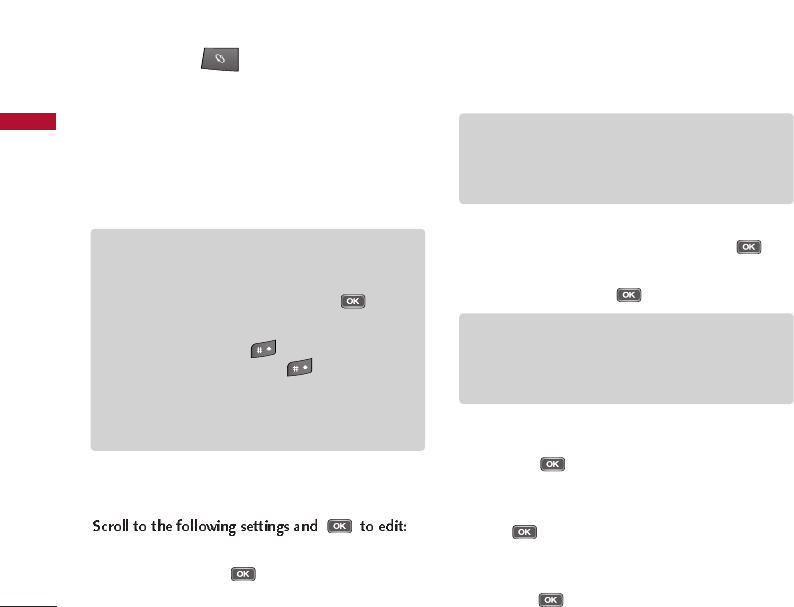
Profiles [ - 8]
58
Profiles
You can manage the call, message, and other alert
settings of your phone.
1. To change the profile, scroll to the desired profile,
press the left soft key
[Options]
and select
Activate
.
2. To modify a profile, scroll to it, press the left soft
key
[Options]
, and select
Personalise
.
]
Ring tone:
To change the ringing tone, scroll to the
new tone and press .
]
Video call tone:
To change the ringing tone for a
video call, scroll to the new tone and press .
]
Ring type:
To change the ringing type, scroll to the
desired type and press .
]
Ring volume:
To increase or decrease the ringing
tone volume, press the right or left navigation key.
And press .
]
Message alert tone:
To change the alert tone for
messages you receive, scroll to the new tone and
press .
]
E-mail alert tone:
To change the alert tone for e-
mail messages you receive, scroll to the new tone
and press .
Note
]To change profiles in any view, briefly press the
Power key on the right side of the phone. Scroll to
the profile you want to use and press .
]To quickly activate the Silent profile in standby
mode, press and hold . To return to General
profile, again press and hold .
]In Offline profile, you cannot make or receive calls
or use other features that require network
coverage.
Tip
]To listen to a tone before selecting it, scroll to the
tone. After a moment, playback will start. To end
playback, press any key.
Tip
]When you select Ascending, the ringing volume
starts from level one and increases level by level to
the maximum volume you set in the next setting.

Profiles
59
]
Vibrating alert:
To have your phone vibrate for
incoming calls and messages, select
On
.
]
Keypad tones:
To change the volume level of the
keypad tones, scroll to the new level and press .
]
Warning tones:
To set the phone to sound warning
tones, select
On
.
]
Alert for:
To set the phone to ring only when calls
arrive from members of a specific contact group or
groups, scroll to each group and press to mark
it. Once you have selected the desired groups, press
OK.
To save your settings, press
Back.
3. To create a new profile with your own sound
settings, press the left soft key
[Options]
and
select
Create new
.
Note
]The General and Offline profiles cannot be
renamed.
]Some settings are not available with the Offline
profile.
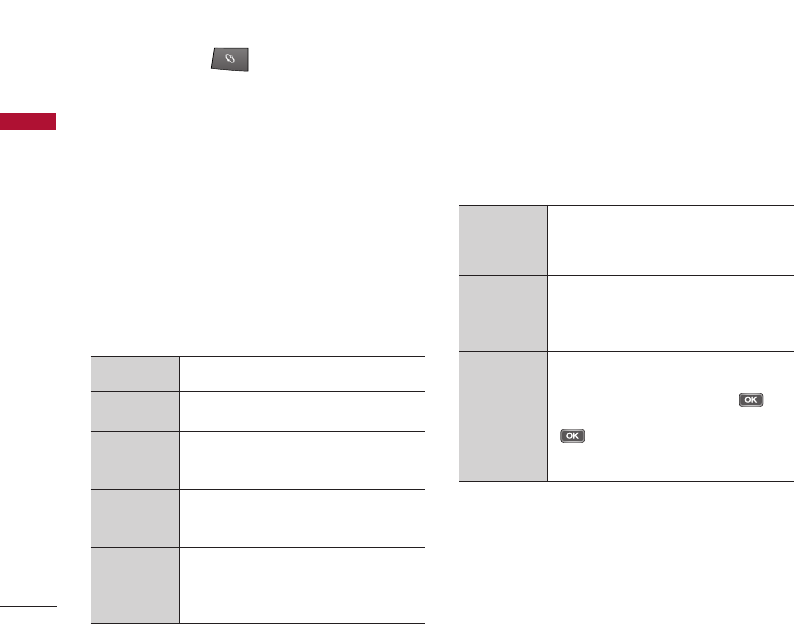
Settings [ - 9]
60
Settings
General
You can edit the general settings of your device or
restore the original default device settings.
Personalisation
To edit settings related to the display, standby mode
and general functionality of your device.
]
Display:
You can edit brightness, list font size and
other display settings. After setting each value, press
the right soft key [Back].
]
Standby mode:
To select the general theme for
your device, edit the theme settings and display or
hide the operator logo. After setting each value,
press the right soft key [Back].
]
Tones:
To edit settings for the various sounds
produced by your phone.
]
Themes:
To change the look of your device's
display.
Brightness To darken or brighten the display, press the
left/right navigation key and press OK.
List font size You can adjust the size of the text and icons
on the display: Large, Normal or Small.
To decrease or increase the power saver time-
out, press the left/right navigation key and
press OK.
To key in a note or select an image to greet
you when you switch on the phone, scroll to
Text or Image and press OK.
Light time-out To increase or decrease the period of time for
which the light stays on when you stop using
the phone, press the left/right navigation key
and press OK.
Power saver
time-out
Welcome
note / logo
Active standby To display today's entries from Calendar,
show your To-do tasks and make shortcuts to
different applications available from standby
mode, select On.
Shortcuts To change the shortcuts available in standby
mode from the selection keys on the bottom
of the display and when you press the
navigation key in any direction.
To select the application shortcuts that
appear on the display in Active standby, scroll
to each shortcut setting and press .
Scroll to the desired application and press
. (Note: You can also set the functions
assigned to soft keys when Active standby is
set to On.)
Active standby
apps.
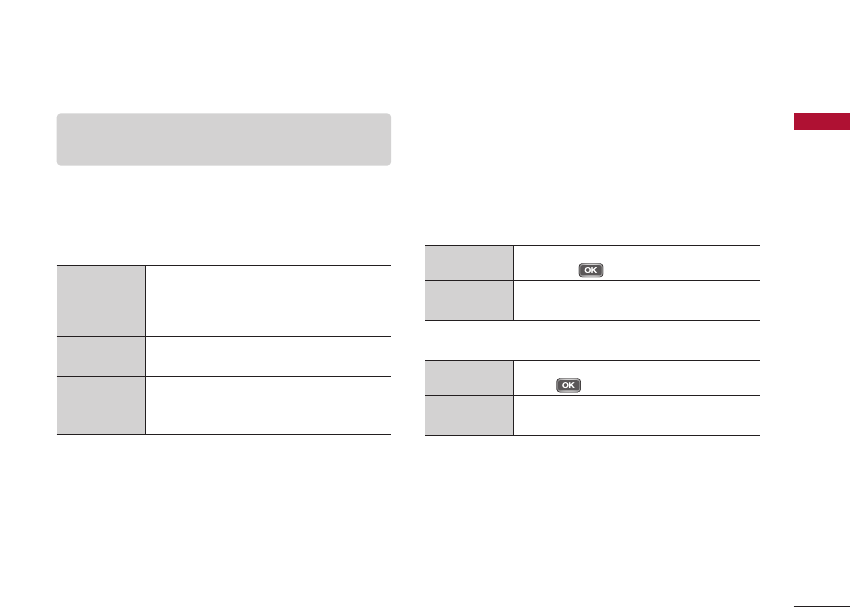
61
Settings
]
Language:
To select the languages for the phone
texts and for you to write messages, notes and other
texts. After setting each value, press the right soft
key [Back].
Date and time
To edit time and date settings.
Enhancement
You can edit settings related to the various
enhancements such as
Headset
and
Wireless car kit
you can use with your device. In most enhancement
settings, you can select the profile to use and answer
incoming calls automatically whenever you use the
enhancement. Some enhancement connectors do not
indicate which type of an enhancement is connected to
the device.
]
Headset
]
Wireless car kit
Security
You can edit settings related to the security of your
personal information on your phone or SIM card and
data connections between your device and the network.
]
Phone and SIM card:
To change the PIN and other
security codes and edit other security settings for
your phone and SIM card.
Phone language Scroll to the desired language for the display
texts and press OK. If you select Automatic,
the language is selected according to the
information on your SIM card.
Scroll to the desired language for writing text
and press OK.
To use predictive text input by default, select
On. (Note: A predictive text dictionary is not
available for all languages.)
Writing
language
Default profile Scroll to the profile to use with the headset
and press .
To answer calls automatically after five
seconds when you use the headset, select On.
Automatic
answer
Default profile Scroll to the profile to use with the car kit and
press .
To answer calls automatically after five
seconds when you use the car kit, select On.
Automatic
answer
Predictive
text
Note
]Please refer to page 83 for more information.

Settings
62
Settings
To protect your phone and SIM card against
unauthorised use, select On. The phone asks
for the PIN code when it is switched on.
PIN code To change the current PIN code, key in the
old PIN code once, the new PIN code twice,
and press OK. (Tip: The PIN codes are saved
on your SIM card, not in the phone memory.
Therefore, the PIN settings only affect the
current SIM card.) (Note: The PUK (Personal
Unblocking Key) codes are required to
change blocked PIN codes. If these codes are
not supplied with the SIM card, contact the
SIM card vendor.)
PIN2 code To change the current PIN2 code, if supplied
with your SIM card, key in the old PIN2 code
once, the new PIN2 code twice, and press
OK. (Note: The PIN2 code is required to
access some network services. Your SIM card
must support these services.) (Note: The
PUK2 (Personal Unblocking Key) codes are
required to change blocked PIN2 codes. If
these codes are not supplied with the SIM
card, contact the SIM card vendor.)
PIN code
request
To lock the keypad when your device has
been idle for a certain period of time so that
no keys are accidentally pressed, scroll to
User defined and press OK. Key in the
time-out period and press OK. (Tip: To use
the keypad again, press the left selection key
and press OK in quick succession.)
To have the system lock itself when left idle
for a certain period of time, scroll to User
defined and press OK. Key in the time-out
period in minutes and press OK. You need
the lock code to change this setting.
Lock code To change the current lock code that is used
to unlock the phone if it locks itself, key in
the old code once, the new lock code (five
digits) twice, and press OK.
To prevent the use of your phone with an
unauthorised SIM card, select Yes. The
phone then asks for the lock code every
time a new SIM card is inserted.
To see the confirmation messages sent
between the phone and the network when
you use network services supported by your
SIM, select Yes.
Phone autolock
period
Confirm SIM
services
Lock if SIM
card changed
Keypad
autolock period

63
Settings
]
Certificate management
To view and manage the digital certificates in your
phone.
]
Security module
To view or edit security modules.
Factory settings
To restore the default settings of your device or
remove any operator settings, press the left soft key
[Yes] and key in the lock code.
Phone
You can edit the general settings related to making and
receiving calls.
Call settings
]
Send my caller ID
:Scroll to
Yes
to display your
caller identity to the people you call,
No
to hide it
or
Set by network
to follow the default setting of
your home network.
]
Call waiting
:To be notified of incoming calls while
you have a call in progress, select Activate.
]
Reject call with SMS
:To send an explanatory text
message to callers when you reject their call, select
Yes
.
]
Message text
:Key in the text for the message to
send to rejected callers.
]
Image in video call
:To send a still image to video
callers if you disable sending your video during the
calls, scroll to
Use selected
and press
OK
. Select
the desired image.
]
Automatic redial
:To have your phone redial when
numbers are busy or calls are not answered, select
On.
]
Show call duration
:To have the length of a call
displayed during the call, select Yes.
]
Summary after call
:To have the duration of a call
briefly displayed after the call, select On.
]
Speed dialling
:To call the phone numbers to which
you have assigned speed dialling keys by pressing
and holding the speed dial key, select On.
]
Anykey answer
:To answer incoming calls by
pressing any key except the End and Power keys,
select
On
.

Settings
64
Settings
]
Line in use (shown if ALS is supported by SIM):
Select either of your phone lines as the primary line
for making calls and sending messages.
]
Line change (shown if ALS is supported by SIM):
To prevent the primary line from being changed,
select
Disable.
You need your PIN2 code to change
this setting.
Call divert
You can divert incoming calls to your voice mailbox or
to another phone number.
]
Voice calls:
You can divert incoming voice calls to
your voice mailbox or to another phone number.
Scroll to the following divert options and press .
Select
Activate
>
To voice mailbox
or
To other
number
.
-
All voice calls:
Diverts all incoming calls.
-
If busy:
Diverts incoming calls when you have an
active call or reject a call.
-
If not answered:
Diverts calls after your phone
rings for a specified time. Scroll to the time and
press
OK.
-
If out of reach:
Diverts calls when the phone is
either switched off or out of network coverage.
-
If not available:
To activate the last three
settings, to divert if busy, not answered or out of
reach.
To cancel the diverting of calls, scroll to the active
divert options, press the left soft key
[Options]
and
select
Cancel
.
To check your current diverts, scroll to the call divert
options, press the left soft key
[Options]
and select
Check status
.
]
Data and video calls:
You can divert incoming data
and video calls to another phone number. Scroll to
the following divert options and press . Select
Activate
. Key in the number and press
OK
.
-
All data and video calls:
Diverts all incoming
calls.
Note
]The accessibility of some Call settings depends on
the availability and your subscription to the
network services. Contact your service provider
for more information.

65
Settings
-
If busy:
Diverts incoming calls when you have an
active call.
-
If not answered:
Diverts calls after your phone
rings for a specified time. Scroll to the time and
press
OK
.
-
If out of reach:
Diverts calls when the phone is
either switched off or out of network coverage.
-
If not available:
To activate the last three settings,
to divert if busy, not answered or out of reach.
To cancel the diverting of calls, scroll to the active
divert options, press the left soft key
[Options]
and
select
Cancel.
To check your current diverts, scroll to the divert
options, press the left soft key
[Options]
and select
Check status.
To save your settings, press the right sot key
[Back]
.
Call barring
You can restrict the receiving of calls: Outgoing
calls/ International calls/ International calls
except to home country/ Incoming calls/
Incoming calls when abroad.
To edit mobile call barring settings, you need a
password. You obtain the barring password from your
service provider upon subscription to this network
service.
Call barring affects all voice and data calls, except
emergency calls.
Scroll to barring options, press and select:
]
Activate to restrict calls.
]
Cancel to undo call restriction.
]
Check status to see if calls are restricted or not.
To undo mobile call barring, press the left soft key
[Options] and select Cancel all barrings.
To change the barring password, press the left soft
key [Options] and select Edit barring password.
Key in the old password once, the new password
twice and press OK. To save your settings, press the
right soft key [Back].

Settings
66
Settings
Network
You can select the network type, the manner of
selecting networks and
indicate when your phone is
used in a Micro Cellular Network.
]
Network mode:
Press , scroll to the network
type and press .
]
Operator selection:
Define how to choose between
different available networks when travelling, for
example.
-
Manual
: You can select the network yourself.
Scroll to the desired network and press .
-
Automatic:
To have the network selected
automatically.
]
Cell info display
: To indicate when your phone is
used in a Micro Cellular Network (MCN), select
On.
The MCN indicator is only displayed in standby mode.
To save your settings, press the left soft key
[Back].
Connection
You can edit access point and other connection settings.
Bluetooth
You can edit settings for Bluetooth connectivity.
For further information, please refer to page 93.
Bluetooth provides you with wireless connections to
other Bluetooth devices such as computers or other
phones.
Note
]This setting may be preset for your phone and not
available for editing.
Tip
]Manual selection can be useful when you know
that one network is less expensive than another or
that it provides faster data transmission.
Tip
]In a network based on MCN technology, local
calls may cost less.
Note
]To view or edit other settings, press the left/right
navigation keys.

Settings
67
Within a maximum range of 10 metres, you can transfer
data, such as messages or images, between your phone
and other Bluetooth devices.
]
Bluetooth:
To enable wireless connections to other
Bluetooth devices, select
On.
]
My phone's visibility:
Set the visibility of your
phone to other Bluetooth devices.
-
Shown to all:
Allows other Bluetooth devices to
find your phone whenever Bluetooth is switched on.
-
Define period:
You can set a specific time
period during which your phone is visible to other
devices. After the time expires, your phone is
hidden.
-
Hidden:
To prevent other Bluetooth devices from
finding your phone.
]
My phone's name:
You can change the name of
your phone, which is visible to other devices that
search for Bluetooth devices. Key in the new name
and press
OK.
USB
You can change the device type to which you normally
connect your phone with the USB cable.
]
USB mode
-
PC Suite:
To connect PC Suite to your phone via
the USB cable. With PC Suite, you can back up
data from your phone to a PC and restore it back
to your phone, synchronise data between your
phone and PC, transfer files and use it for other
purposes. You need to install PC Suite on your
PC.
Note
]Your Paired devices can still connect to your
phone even if you select Hidden.
Tip
]Give a unique name to your phone to make sure it
is easy to recognise when there are several
Bluetooth devices in the vicinity.
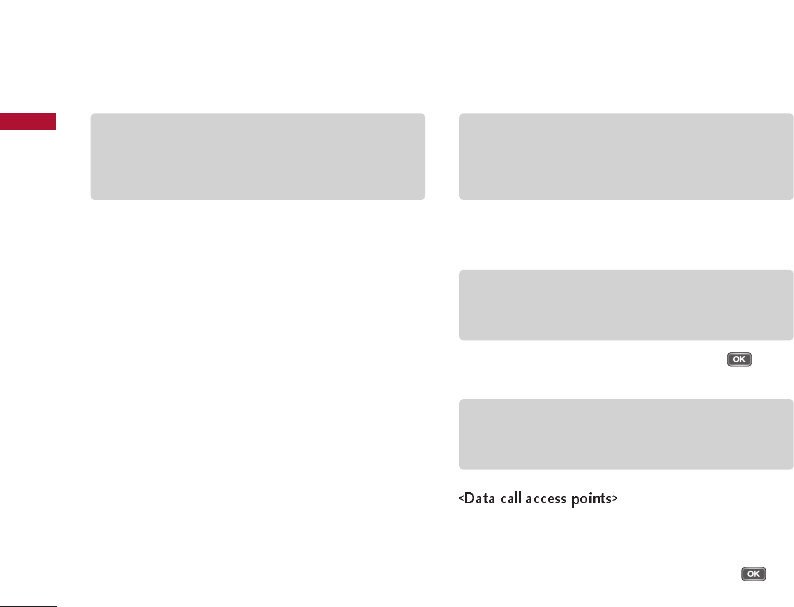
Settings
68
Settings
-
Data transfer:
To access and transfer data, such
as text or music files, between your memory card
and a compatible device, such as a computer,
using USB. For
Data transfer
with a USB
connection, you do not need to install anything
on your phone or the other device.
]
Ask on connection:
Select
Yes
to select the
USB
mode
every time you use the USB cable to connect
your phone to another device.
Access points
You can view, create, and manage access points. An
access point is where your phone connects to the
network by way of a data call or packet data. To use e-
mail and multimedia services or to browse web pages,
you must first define internet access points for these
services.
1. To create a new access point, press the left soft key
[Options]
and select
New access point
.
2. Scroll to the following settings and press to
edit.
]
Connection name:
Key in a name that is easy to
remember and press
OK.
]
Data bearer:
Scroll to
Data call
and press .
Note
]Some or all access points may be preset for your
phone, and you may not be able to create, edit, or
remove them.
Tip
]To use an existing access point as the basis of the
new access point, select Duplicate access point.
Note
]Contact your service provider for the correct
access point settings.
Note
]When you synchronise data between your phone
and PC, the synchronisation must be started from
the PC.
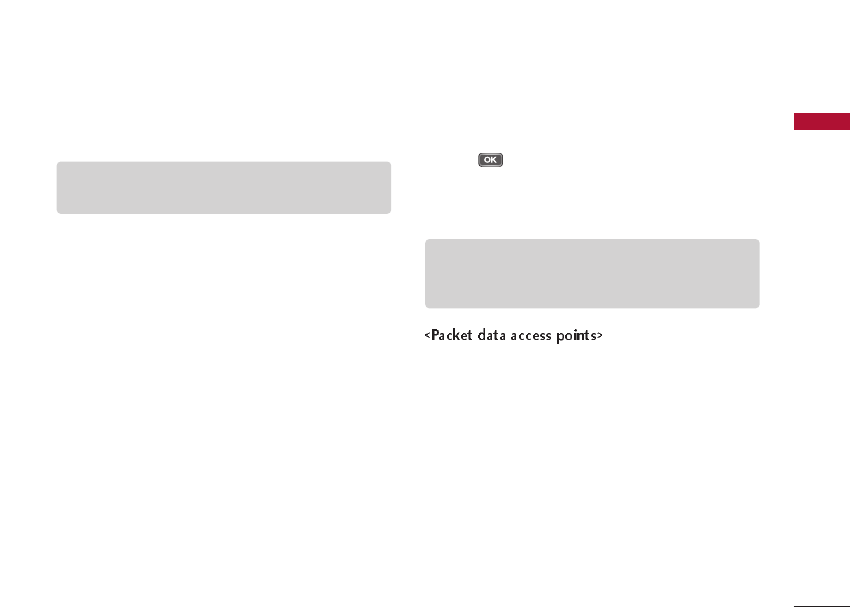
69
Settings
]
Dial-up number:
Key in the modem telephone
number of the access point.
]
User name:
Key in your user name, if required by
the service provider. Press
OK.
]
Prompt password:
Select
Yes
to key in your
password each time you log into a server, or
No
to
save the password in your phone memory and
automate the login.
]
Password:
Key in your password for the service and
press
OK.
]
Authentication:
Select
Secure
to always use
encryption when sending your password, or
Normal
to use encryption when possible when sending your
password.
]
Homepage:
Key in the web address of the page
that appears when you connect to the web with this
access point.
]
Data call type:
Select
Analogue
.
]
Maximum data speed:
Scroll to the data transfer
speed to which you want to limit the connection and
press . If you select
Automatic
, the data
transfer rate is determined by the network, and it
may be affected by the amount of data transferred in
the network.
]
Connection name:
Key in a name that is easy to
remember and press
OK.
]
Data bearer:
Scroll to
Packet data
and press
OK.
]
Access point name:
Key in the name provided by
your service provider and press
OK.
]
User name:
Key in your user name, if required by
the service provider. Press
OK.
]
Prompt password:
Select
Yes
to key in your
password each time you log into a server, or
No
to
save the password in your phone memory and
automate the login.
Tip
]Use + in front of international numbers.
Note
]Some service providers may charge you more for
higher data rates.

Settings
70
Settings
]
Password:
Key in your password for the service and
press
OK.
]
Authentication:
Select
Secure
to always use
encryption when sending your password, or
Normal
to use encryption when possible when sending your
password.
]
Homepage:
Key in the web address of the page
that appears when you connect to the web with this
access point.
3. To save your settings, press the right soft key
[Back].
The icons on the left-hand side of the access points
indicate their data bearers.
To edit an access point, scroll to it and press .
To delete an access point, scroll to it and press .
Packet data
You can set when to use packet data connections and
key in the access point to be used if you use your
phone as a modem for a computer.
]
Packet data connection:
Define when to use
packet data connections.
-
When available:
Registers to the packet data
network when you switch on your phone in a
network that supports packet data.
-
When needed:
Establishes a packet data
connection only when an application or action
requires it.
]
Access point:
If you use the phone as a modem to
enable packet data connectivity from a computer,
scroll to this and press . Key in the access point
name and press
OK.
Contact your service provider
for the access point name for modem connections.
To save your settings, press the right soft key
[Back].
Note
]For further information, please refer to the Help
option on the handset.
Note
]This setting affects all access points for packet
data connections.

71
Settings
SIP settings
You can create or edit session initiation protocol (SIP)
profiles, which are necessary for making Internet calls,
for example.
The Session Initiation Protocol (SIP) is used for
creating, modifying, and terminating communications
sessions, such as internet calls, with one or more
participants. SIP profiles include settings for these
sessions. (The SIP profile used by default for a
communication session is underlined.)
To create a SIP profile, press the left soft key
[Options]
and select
New SIP profile >Default
profile
or
Use default profile
to select a profile as
the basis for the new profile.
To edit a SIP profile, scroll to it and press .
To select the SIP profile you want to use by default for
communications sessions, scroll to the profile, press
the left soft key
[Options]
and select
Default
profile
.
To delete a SIP profile, scroll to it and press .
Configurations
You can view or delete trusted servers from which your
phone may receive configuration settings. You can
receive messages from your network operator, service
provider, or company information management
department. These messages contain configuration
settings for trusted servers and are automatically saved
in
Configurations.
From trusted servers you may
receive configuration settings for access points,
multimedia or e-mail services, and synchronisation
settings.
To delete configurations for a trusted server, scroll to
the server and press . The configuration settings
for other applications provided by this server are also
deleted.
Note
]SIP profiles may be preset in your device or you
may receive them from your service provider. You
may not be able to edit or manage SIP profiles.

Settings
72
Settings
Applications
You can edit the settings of different applications.
RealPlayer
You can change RealPlayer video or connection
settings.
]
Video:
You can set the image contrast and select
whether video clips are automatically replayed when
they finish playing.
-
Contrast:
To make the image lighter or darker,
press the left/right navigation keys.
-
Loop:
To automatically replay video clips when
they finish playing, select
On.
]
Streaming:
You can select whether or not to use a
proxy server and change the default network
connection settings.
-
Proxy:
You can select whether to use a proxy
server and key in the proxy server ’s IP address
and port number.
-
Network:
You can change the access point to
connect to internet and set the port range used
when connecting.
Camera
You can edit image or video settings. For further
information, please refer to p.55-58.
Voice recorder
You can select the recording quality and default
memory for your sound clips.
]
Recording quality:
To record sound clips you can
then easily include in your multimedia messages and
send to other devices, select
MMS compatible
.
]
Memory in use:
Select
Phone memory
or
Memory card
as the default memory in which to
save your sound clips.
Note
]For example, you may need to delete trusted
server configurations and the configuration
settings provided by it when you change your
service provider.

73
Settings
App. manager
You can edit the Application manager settings.
Some software packages that you install in your device
may contain certificates for additional security.
]
Software installation:
Select
Signed only
to install
applications with verified digital signatures only.
]
Online certificate check:
You can check the
validity of certificates when installing applications.
-
Must be passed:
Checks certificate validity when
installing an application. If validity cannot be
verified, the installation will be cancelled
automatically.
-
On:
Checks certificate validity when installing an
application. If validity cannot be verified, you will
be asked whether you want to continue installing
the application.
-
Off:
Select this if you trust the validity of the
certificate.
]
Default web address:
If the software package
certificate does not include a web address to check
its validity, its validity can be checked via the default
web site. To change the default address, select this.
Key in the new address and press .
Log
You can set the time period to keep log events and to
display call duration during calls. Scroll to the number
of days after which logged communication events are
automatically deleted and press .
Note
]These settings do not affect Java applications.
Note
]If you select No log, all log contents are
permanently deleted.
Tip
]You may also edit the settings of other
applications installed in your device by your
service provider that appear on the list.

Tools [ - ]
74
Tools
Call mailbox Menu *.1
You can use the network service of voice mail that
works as an answering machine for your phone.
A call mailbox is a network service that works as an
answering machine where people who are unable to
reach you can leave messages.
If your phone prompts you for the call mailbox number
that you cannot recall, press the left soft key [Find] to
search for it in
Contacts.
Using the left soft key [Options], you can access the
followings.
]
Define number:
Key in the phone number of your
call mailbox.
]
Call voice mailbox:
Makes a call to the voice
mailbox.
]
Change number:
You can change the phone
number of your call mailbox.
Speed dial Menu *.2
You can assign speed dialling keys (from to )
to phone numbers in your contacts directory.
Some number keys may be assigned as speed dials to
special phone numbers. For example, number is
reserved for your call mailbox.
To assign speed dialling keys:
1. Scroll to an available speed dialling number and
press .
2. Select
Assign.
3. Select the contact to whom you want to assign the
speed dial. Select the phone number.
Tip
]With the call diverting network service, you can
direct incoming calls to your call mailbox. [Menu
>Settings >Phone >Call divert >Voice calls]
(Please refer to page 72.)
Tip
]To quickly call your call mailbox in standby mode,
press and .

75
Tools
You can call a phone number linked to a speed dialling
key in standby mode by pressing the speed dial and
then .
To assign a speed dialling key to a different phone
number:
1. Scroll to the speed dialling number and press the
left soft key [Options].
2. Select
Change.
3. Select the new contact and number.
You can remove a number linked to a speed dial by
pressing the left soft key [Options] and selecting
Remove.
The contact and phone number you remove will remain
in your
Contacts.
Themes Menu *.3
You can change the look of your phone’s display.
In Themes, you can select different themes, which
consist of various settings that affect the appearance
of your phone’s display. Some themes may also include
ringtones or message alert tones.
General
You can preview or change the theme used for all
applications that do not have their own themes or
download more themes to your phone.
Menu view
You can change the display appearance of applications
in
Menu
between
Grid
and
List
formation.
Wallpaper
You can change the background image on the display
in standby mode.
To change the background image on the display in
standby mode, scroll to Image and press . Scroll to
the desired image and press the left soft key [Select].
Note
]To call a number linked to a speed dialling key just
by pressing and holding the speed dial in standby
mode, open Settings >Phone > Call >Speed
dialing and select On.

Tools
76
Tools
Power saver
You can change the option that appears as power
saver when your device has been idle and no keys have
been passed for some time.
]
Date and time:
Uses the current date as power
saver.
]
Text:
You can key in the text to appear as the power
saver.
]
Animation:
You can select an animation as your
power saver. Scroll to the desired animation and
press .
Using the left soft key [Options], you can access the
followings.
]
Preview:
You can see a preview of the power saver.
]
Settings:
You can view or edit the power saver
settings.
Actv. keys Menu *.4
You can view and manage usage rights for media files in
your phone. Some media files, such as images, music or
video clips are protected by digital usage rights.
The activation keys for such files may allow or restrict
their usage. For example, with some activation keys you
may listen to a music track only a limited number of
times. During one playback session you may rewind,
fast-forward or pause the track, but once your stop it,
you have used one of the instances allowed.
Valid keys
To view detailed info about your usage rights for a
media file, such as their validity status and whether you
can send the media file to other devices, scroll to the
corresponding activation key and press .
Tip
]You can key in the Power saver time-out after
which the power saver is turned on, in Menu >
Settings >General >Personalisation >
Display.
Note
]You can also choose any other power saver you
may have installed on your phone.

77
Tools
Using the left soft key [Options], you can access the
followings.
]
Get new key:
You can buy usage rights for a media
file.
]
Reload:
To update the info about whether the
media files connected to the activation keys are
saved on the phone and the validity of the keys.
To delete the activation key for a media file and the
media file itself, scroll t o the key and press .
Invalid keys
To view detailed info about your expired or missing
usage rights for a media file, scroll to the
corresponding activation key and press .
Using the left soft key [Options], you can access the
followings.
]
Get new key:
You can buy more instances or extend
the usage period for a media file.
]
Reload:
To update the info about whether the
media files connected to the activation keys are
saved on the phone and the validity of the keys.
Tip
]In the activation key details view, you can see the
validity status of the key, details about your usage
rights and restrictions for the corresponding
media file and where the media file is currently
saved on your device.
Tip
]Activation keys expire when you run out of
instances when you are allowed to use a media file
or the time period for using the file ends.
]In the activation key details view, you can see the
validity status of the key, details about your usage
rights and restrictions for the corresponding
media file and where the media file is saved on
your device.
Note
]You may not be able to buy more instances or
extend the usage period for all media files.

Tools
78
Tools
Not in use
Unused activation keys are usually for media files that
have been deleted from the device or saved on a
removed memory card.
To view detailed info about an activation key not in
use, scroll to it and press .
Using the left soft key [Options], you can access the
followings.
]
Reload:
To update the info about whether the
media files connected to the activation keys are
saved on the phone and the validity of the keys.
]
Restore activation keys:
Select this to reinstate the
activation keys saved in a backup file on your device.
Help Menu *.5
You can read instructions about using the applications
and functions of your phone.
About Menu *.6
You can see the copyright information of this product.

Connectivity [ - 0]
79
Connectivity
IM(Instant Messasging) Menu 0.1
You can converse with individual or multiple IM users
by exchanging instant messages.
To converse with IM users and to view and edit your IM
contacts, you must first log into the IM service. Press
the left soft key
[Options]
and select
Log in
. When
you register for this service, your service provider
informs you of your user name, password and the
appropriate settings to log in.
Using the left soft key [Options], you can access the
followings.
]
Change own availability:
You can change your
online status, which is shown to other IM users.
]
Log in/ Log out:
To connect to the IM server or
disconnect from the IM server.
]
Settings:
You can edit IM application or server
settings.
Conversations
You can start or continue a conversation with an IM
user.
To start a conversation, press the left soft key
[Options]
and select
New conversation
.
]
Enter user ID:
You can key in the ID of the IM user.
]
Select from contacts:
You can select the other
party of the conversation from your
IM contacts.
Tip
]To automatically connect to the IM server when
you open the application, press the left soft key
[Options] and select Settings >IM login type
>On app. start-up.
Note
]To converse with other IM users, you must first
log in to the IM service. Press the left soft key
[Options] and select Log in.
Tip
]Each user ID is unique and is provided by the
service provider during registration. To search for
IM users and user IDs, open IM contacts and
press the left soft key [Options] and select New
IM contact >Search from server.

Connectivity
80
Connectivity
To continue a conversation, scroll to it and press .
Key in a message and press to send it.
To end a conversation, scroll to it and press .
To view an invitation to join a group conversation,
scroll to it and press . Press the left soft key
[Options]
to
Join
the group or
Reject
the invitation
and send a message to its sender.
Using the left soft key [Options] in a conversation or
invitation, you can access the followings.
]
Save:
To save a received image in
My stuff
.
]
Insert smiley:
You can add a string of text
characters that form a face that expresses a mood to
your message.
]
Send image:
You can send a saved image
(From
My stuff)
or new image
(New image)
.
]
Forward:
You can forward the message to another
IM contact or group.
]
Add to IM contacts:
You can add the other party
to your IM contacts.
]
Record chat:
You can save a copy of the
conversation.
]
Stop recording:
Select this to stop saving the
conversation.
]
Blocking options:
You can prevent you from
receiving messages from the other party or another
IM user or view a list of your blocked IM users.
]
Change own availability:
You can change your
online status, which is shown to other IM users.
]
End conversation:
Select this to finish the
conversation.
]
Writing language:
You can change the language in
which you write your messages.
Note
]All conversations end when you log into a
different IM server, when you log into the same
server with a different user name or when you exit
the application.
Note
]To delete the invitation without sending a
rejection to its sender, scroll to it and press .

81
Connectivity
IM contacts
You can create, edit or view the online status of your
IM contacts.
To open or close a contact list, scroll to it and press
.
To create an IM contact, press the left soft key
[Options]
and select
New IM contact.
]
Add from Contacts:
To select a contact from your
Contacts
directory and search for the contact on
the IM server.
]
Enter manually:
To key in the contact info.
]
Search from server:
To find IM users.
To save the new contact, press
Done.
Scroll to your own status, contact list or contact and
press the left soft key
Options.
You can access the
followings.
]
Change own availability:
You can change your
online status, which is shown to other IM users.
]
Status message:
You can key in a more detailed
note about your availability shown to other IM users.
]
Open conversation:
Select this to start or continue
conversation with the contact.
]
Edit:
You can change your own
Alias
name that is
visible in other IM users' devices.
]
New contact list:
You can create a contact list for a
specific group of IM cont acts.
]
Contact details:
You can view detailed information
about the group.
Note
]To view your IM contacts, you need to log into
the IM service.
Tip
]An indicator on the left-hand side of the contact
name shows the online status of your IM contacts.
Tip
]To find a specific contact or contact list, key in
the first letters of the contact or list name. The
contacts and contact lists whose names match
your input appear on the display.

Connectivity
82
Connectivity
]
Reload users' availability:
Select this to update the
online status of your IM contacts.
]
Contact options:
You can edit or delete the
contact, move it to another contact list or receive a
note when the contact's online status changes.
]
Belongs to groups:
You can see the IM groups the
contact has joined.
]
Blocking options:
You can prevent you from
receiving messages from the other party or another
IM user or to view a list of your blocked IM users.
]
Log out:
Select this to disconnect from the IM
server.
]
Settings:
You can edit IM application or server
settings.
To delete an IM contact, scroll to the contact and
press .
IM groups
You can start or continue a group conversation with
multiple IM users.
To create an IM group, press the left soft key
[Options]
and select
Create new group.
To join an IM group or to continue a group
conversation, scroll to the group and press . Key
in a message and press to send it.
Tip
]To update online statuses automatically, select
Settings >IM settings >Availability reloading
>Automatic.
Note
]IM contacts and IM groups may not be available
if you have not logged into an IM server or if the
server does not support IM groups.
Tip
]To join an IM group that is not saved to your
phone, press the left soft key [Options] and
select Join new group. Key in the group ID and
press .
]To search for IM groups and group IDs, press the
left soft key [Options] and select Search.

83
Connectivity
Scroll to an IM group and press the left soft key
[Options]
to access the followings.
]
Leave IM group:
Select this to end participation in
the group conversation.
]
Group
-
Details:
You can view detailed information about
the group.
-
Save:
Select this to save the group.
-
View participants:
You can view the current
members of the group.
-
Settings:
You can edit group settings.
]
Change own availability:
You can change your
online status, which is shown to other IM users.
]
Log out:
Select this to disconnect from the IM
server.
]
Settings:
You can edit IM application or server
settings.
To remove an IM group, scroll to it and press .
To open an image included in a message, scroll to it
and press .
Press the left soft key
[Options]
to access the
followings.
]
Save:
You can save an image in
My stuff
.
]
Reply:
To send a message only to the sender of the
selected message.
]
Forward:
To forward the selected message to
another IM group or contact.
-
Insert smiley:
You can add a string of text
characters that form a face expressing a mood to
your message.
-
Send image:
You can send a saved image
(From
My stuff)
or new image
(New image)
.
-
Send invitation:
You can invite an IM user to
join the group.
Note
]You can only select this option if you have editing
rights to the group.
Note
]You cannot remove a group to which you are still
joined. Press the left soft key [Options] and
select Leave IM group before removing it.

Connectivity
84
Connectivity
-
Send private message:
You can send a message
to selected members of the group. Select the
recipients. Key in the message and press .
-
Leave IM group:
Select this to end your
participation in the group conversation.
-
Group
•
Save:
Select this to save the group.
•
View participants:
You can view the current
members of the group.
•
Settings:
You can edit group settings.
-
Change own availability:
You can change your
online status, which is shown to other IM users.
-
Record chat:
You can save a copy of the group
conversation. Key in a name for the conversation
and press .
-
Stop recording:
Select this to stop saving the
conversation.
-
Writing language:
You can change the language
in which you write your messages.
Recorded chats
You can view previous IM conversations you have
saved.
To view a recorded chat or an IM conversation, scroll
to it and press the navigation centre key.
Using the left soft key
[Options]
, you can access the
followings.
]
Send:
You can send the conversation to other
compatible devices.
]
Change own availability:
You can change your
online status, which is shown to other IM users.
]
Log in:
Select this to connect to an IM server.
]
Log out:
Select this to disconnect from the IM
server.
]
Settings:
You can edit IM application or server
settings.
Note
]You can only select this option if you have
editing rights to the group.

85
Connectivity
To delete a recorded chat, scroll to it and press .
Conn.mgr. Menu 0.2
You can manage active data connections.
To view detailed connection info, such as the duration,
speed of data transfer, and the amount of data sent or
received, scroll to the connection and press .
To end a connection, scroll to it and press .
To end all connections, press the left soft key
[Options] and select
Disconnect all.
Bluetooth Menu 0.3
You can make a wireless connection to other
compatible devices such as computers.
Bluetooth provides you with wireless connections to
other Bluetooth devices such as computers or other
phones.
Within a maximum range of 10 metres, you can transfer
data, such as messages or images, between your phone
and other Bluetooth devices.
]
Bluetooth:
To enable wireless connections to other
Bluetooth devices, select
On.
]
My phone's visibility:
Set the visibility of your
phone to other Bluetooth devices.
-
Shown to all:
Allows other Bluetooth devices to
find your phone whenever Bluetooth is switched
on.
-
Define period:
You can set a specific time
period during which your phone is visible to other
devices. After the time expires, your phone is
hidden.
Tip
]To delete several chats at once, scroll to each one
and press the left soft key [Options] and select
Mark/Unmark >Mark to put a tick next to it.
Once you have ticked everything that you want to
delete, press .
Tip
]You can also play phone -to-phone games via
Bluetooth.

Connectivity
86
Connectivity
-
Hidden:
To prevent other Bluetooth devices from
finding your phone.
]
My phone's name:
You can change the name of
your phone, which is visible to other devices that
search for Bluetooth devices. Key in the new name
and press
OK.
1. Open the application that contains the item you
want to send.
2. Scroll to the item, press the left soft key
[Options]
and select
Send >Via Bluetooth.
3. The phone searches for Bluetooth devices within
range and lists them.
Scroll to the desired device and press to set up
the connection.
Note
]Your Paired devices can still connect to your
phone even if you select Hidden.
Tip
]Give a unique name to your phone to make sure it
is easy to recognise when there are several
Bluetooth devices in the vicinity.
Note
]If you have sent items using Bluetooth before, the
previously selected devices are included in the list.
To search for more Bluetooth devices, go to More
devices and press .
]If the other device requires pairing, agree on a
common passcode with its owner, key in the code
and press OK. Once the connection is established,
the other device is saved in your Paired devices.
]To use a Bluetooth audio enhancement such as
Bluetooth handsfree or headset:
- Pair your phone with the enhancement. See the
enhancement's user guide for the passcode and
further instructions.
- To connect to the audio enhancement, press the
enhancement power key if the enhancement is
not already on. Some audio enhancements
connect automatically to your phone. Otherwise,
open Paired devices, scroll to the enhancement
and press the left soft key [Options] and select
Connect to audio device.

87
Connectivity
1. Press the right navigation key to move to the
Paired
devices
window.
2. Press the left soft key
[Options]
and select
New
paired device.
The phone starts to search for
Bluetooth devices within range.
3. Scroll to the device with which you want to pair and
press .
4. Agree on a common passcode with the owner of the
other device and key it in. Press
OK.
If you trust a paired device, you can allow it to connect
automatically to your phone. Scroll to the device, press
the left soft key
[Options]
and select
Set as
authorised.
This way, you do not have to accept a
device manually every time you connect to it.
To give a nickname to a paired device that is displayed
only in your phone, scroll to the device, press the left
soft key
[Options]
, and select
Assign short name.
To delete pairing with a device, scroll to the device and
press .
USB Menu 0.4
You can transfer data to and from another device using
the USB wire provided in the sales pack.
You can change the device type to which you normally
connect your phone with the USB cable.
USB mode
]
PC Suite:
To connect PC Suite to your phone via
the USB cable. With PC Suite, you can back up data
from your phone to a PC and restore it back to your
phone, synchronise data between your phone and
PC, transfer files and use it for other purposes. You
need to install PC Suite on your PC.
Note
]Some devices have fixed passcodes.
Note
]When you synchronise data between your phone
and PC, the synchronisation must be started from
the PC.

Connectivity
88
Connectivity
]
Data transfer:
To access and transfer data, such as
text or music files, between your memory card and a
compatible device, such as a computer, using USB.
For
Data transfer
with a USB connection, you do
not need to install anything on your phone or the
other device.
Ask on connection
Select
Yes
to select the
USB mode
every time you
use the USB cable to connect your phone to another
device.
Sync Menu 0.5
You can synchronise data in your phone’s contacts,
calendar, notes and text message applications with
corresponding applications on a computer or Internet
server. Synchronisation settings are saved in sync
profiles.
Scroll to a sync profile and press the left soft key
[Options]. You can access the followings.
]
Synchronise:
Synchronises the applications
included in the profile with a remote database.
]
Edit sync profile:
You can edit properties of
selected sync profile.
]
New sync profile:
You can create a sync profile.
]
View log:
You can see the number of added,
updated and deleted entries in the latest
synchronization with the profile.
To delete a synchronization profile, scroll to it and
press .
Note
]The available applications you can synchronise
may vary. Contact your service provider for more
information.
Note
]You cannot remove a PC Suite profile. Because it
is an essential item to sync between phone and
PC Suite.
Tip
]You may want to create multiple sync profile for
an application to vary the data bearer or remote
database with which you synchronise your device.
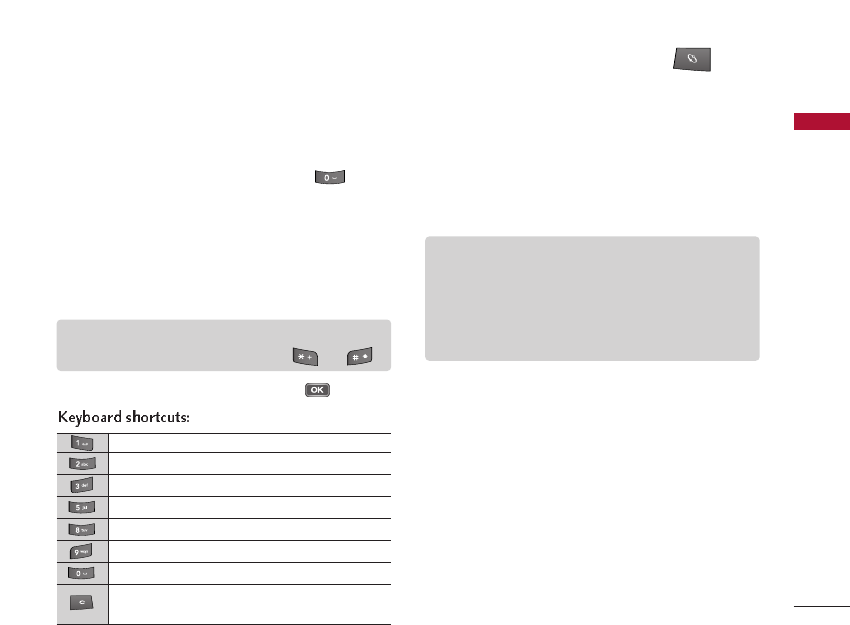
Browser [ - #]
89
Browser
Browsing the web
You can browse web pages in this menu. You can also
access this menu by pressing and holding in
standby mode. Key in the page address and press the
left soft key
[Go to].
When you start to key in the address, addresses of
pages you have previously visited that match your
input appear. To open a page, scroll to the address and
press the left soft key
[Go to].
To open a web link, scroll to it and press .
You can access the followings by pressing the left soft
key [Options].
]
Open link
]
Downloads:
You can view files you are currently
downloading from the web.
]
Go to web address:
Select this to open another
web page.
]
Bookmarks:
You can view the list from which you
can open your favourite web pages.
]
Save as bookmark:
You can save the web address
of a page in your phone and make opening it quick
and easy.
Tip
]To zoom the page in or out, press or .
To open your Bookmarks.
To search for specific text on the page.
To return to the previous page
To switch between your open windows
To toggle page overview on and off
To go to a different web page
To go to your homepage
To close the current window if you have more than
one open window
Tip
]You can download items, such as ringing tones
and operator logos, via the browser. Once
downloaded, they are handled by the respective
applications. For example, a downloaded photo is
saved in My stuff.

Browser
90
Browser
]
Rotate screen:
Select this to rotate display.
]
Navigation options
-
Reload:
Downloads the latest version of the
page.
-
History:
You can view a chronological list of
pages you have visited during the current
browsing session.
-
Page overview:
You can view a small thumbnail
image of the page.
]
Zooming options:
You can increase or decrease the
size of images or text.
]
Window
-
Allow pop-ups:
Allows for automatic opening of
multiple windows.
]
Clear privacy data
-
All:
Deletes info saved in cache, cookies, history,
automatic bookmarks, and forms during your
current browsing session.
-
Clear cache:
Select this to empty the temporary
memory that stores info about your visits to
different web sites.
-
Delete cookies:
Erases the info the network
server collects about your visits to various web
pages.
-
History:
Erases the list of web pages you have
visited during this browsing session.
-
Form/password data:
Select this to delete all
info you may have entered in any web forms
during this browsing session.
Note
]If you access confidential info that requires
passwords such as your bank account, clear the
cache after each use.
Tip
]Cookies are necessary if you shop on the web to
retain the items you buy until you reach the
cashier page, for example. However, the info may
be misused, and you may receive unwanted
advertisements in your phone, for example.

91
Browser
]
Tools
-
Show toolbar:
Select this to show the toolbar
with various functions on the page. To select a
function in the toolbar, scroll to it and press
.
-
Change connection:
You can change your active
connection to the web.
-
Disconnect:
Select this to end your connection
to the web.
-
Save page:
You can save the web page in your
phone for offline viewing.
-
Send:
You can send the URL address of the page
to compatible devices.
]
Find:
You can search for specific text or the numbers
or addresses the page may contain. You can use the
numbers and addresses to call, send messages, open
web pages, or create contact cards, for example.
]
Settings:
You can edit the Web settings.
Saved pages
You can view a saved web page. After scrolling to it,
press .
To find a specific saved page, key in the first letters of
the page title. The list scrolls to pages whose titles
match your input.
Scroll to a saved page and press the left soft key
[Options]
to access the followings.
]
Saved pages
-
Move to folder:
You can move the page to a
different folder.
-
New folder:
You can create a folder to organise
your saved pages.
]
Clear privacy data
-
All:
Deletes info saved in cache, cookies, history,
automatic bookmarks, and forms during your
current browsing session.
Tip
]To save a web page for offline viewing, open the
page when browsing, press the left soft key
[Options] and select Tools >Save page.

Browser
92
Browser
-
Clear cache:
Select this to empty the temporary
memory that stores info about your visits to
different web sites.
-
Delete cookies:
Select this to erase the info the
network server collects about your visits to
various web pages.
-
History:
Erases the list of web pages you have
visited during this browsing session.
-
Form/password data:
Deletes all info you may
have entered in any web forms during this
browsing session.
]
Mark/Unmark:
You can select or cancel selection
of multiple saved pages. A check mark is placed on
the right-hand side of each selected page.
]
Settings:
You can edit the Web settings.
To remove a saved page, scroll to it and press .
Auto. Bookmarks
You can returns to a web page you have recently
visited. After scrolling to the desired page address,
press .
Scroll to a bookmark and press the left soft key
[Options]
to access the followings.
]
Back to page:
You can return to the page you
visited before opening
Bookmarks.
]
Bookmark manager
-
Move:
Select this to rearrange your bookmarks.
-
Move to folder:
Select th is to save the
bookmark in another folder.
-
New folder:
You can create a folder to organise
your bookmarks.
Note
]If you access confidential info that requires
passwords such as your bank account, clear the
cache after each use.
Tip
]Cookies are necessary if you shop on the web to
retain the items you buy until you reach the
cashier page, for example. However, the info may
be misused, and you may receive unwanted
advertisements in your phone, for example.

93
Browser
-
Edit:
You can change the title, URL address,
access point, user name, or password of the
bookmark.
]
Mark/Unmark:
You can select or cancel selection
of multiple bookmarks. A check mark is placed on
the right -hand side of each selected bookmark.
]
Navigation options
-
Go to web address:
You can open another web
page.
-
Homepage:
Select this to open your homepage.
]
Clear privacy data
-
All:
Deletes info saved in cache, cookies, history,
automatic bookmarks, and forms during your
current browsing session.
-
Clear cache:
Select this to empty the temporary
memory that stores info about your visits to
different web sites.
-
Delete cookies:
Erases the info the network
server collects about your visits to various web
pages.
-
History:
Erases the list of web pages you have
visited during this browsing session.
-
Form/password data:
Deletes all info you may
have entered in any web forms during this
browsing session.
]
Tools
-
Change connection:
You can change your active
connection to the web.
-
Disconnect:
Select this to end your connection
to the network.
-
Send:
You can send the bookmark to compatible
devices.
Note
]If you access confidential info that requires
passwords such as your bank account, clear the
cache after each use.
Tip
]Cookies are necessary if you shop on the web to
retain the items you buy until you reach the
cashier page, for example. However, the info may
be misused, and you may receive unwanted
advertisements in your phone, for example.

Browser
94
Browser
]
Details
-
Security:
You can see detailed info about
connection security.
]
Settings:
You can edit the Web settings.
To delete a bookmark, scroll to it and press .
Browser feeds
You can download and manage feeds and blogs.
Blog is short for weblog, which is a continuously
updated web diary meant to be viewed by any web
user.
To download a feed or blog, scroll to it and press
.
You can access the following by press the left soft key
[Options].
]
Refresh:
Updates a feed or blog.
]
Refresh all:
Updates all items in
Browser feeds.
]
Manage feed
-
Move:
To select this to move a feed or blog to
another location in the folder.
-
New folder:
You can create a folder to organise
your feeds and blogs.
-
Move to folder:
Select this to move the feed of
blog to another folder.
-
Edit:
You can change the title or URL address of
a feed.
]
Mark/Unmark:
You can select or cancel selection
of multiple feeds. A check mark is placed on the
right-hand side of each selected feed.
]
Back to page:
Returns to the page you visited
before opening
Browser feeds.
Tip
]Feeds are xml files in various web pages that
usually contain headlines and articles often about
recent news or other topics. To subscribe to
interesting feeds on web pages when browsing,
press the left soft key [Options] and select
Subscribe.

95
Browser
]
Clear privacy data
-
All:
Deletes info saved in cache, cookies, history,
automatic bookmarks, and forms during your
current browsing session.
-
Clear cache:
Select this to empty the temporary
memory that stores info about your visits to
different web sites.
-
Delete cookies:
Erases the info the network
server collects about your visits to various web
pages.
-
History:
Erases the list of web pages you have
visited during this browsing session.
-
Form/password data:
Deletes all info you may
have entered in any web forms during this
browsing session.
]
Settings:
Edits the Web settings.
Note
]If you access confidential info that requires
passwords such as your bank account, clear the
cache after each use.
Tip
]Cookies are necessary if you shop on the web to
retain the items you buy until you reach the
cashier page, for example. However, the info may
be misused, and you may receive unwanted adv
ertisements in your phone, for example.

Installations
96
Installations
App. mgr.
You can install and update Java and other applications
or components compatible with the Symbian operating
system. You can receive software installation packages
via e-mail or multimedia messaging, transfer them from
a computer or download them from the Web.
To download and install software from the Web, select
Download apps.
Scroll to an application and press the left soft key
[Options] to access the followings.
]
Install:
You can install the application in your device.
]
Open:
You can edit security settings for a Java
midlet.
]
View details:
You can view the type, size, supplier,
certificate or other information about the
application.
]
Send:
You can send the application to compatible
devices.
]
Remove:
You can remove an installed application
from your phone.
]
View log:
You can see a list of the applications you
have installed or removed.
]
Settings
: You can edit Application manager settings.
Note
]Only install applications from sources that offer
sufficient protection against harmful software.
]You can also install software in other applications,
such as e-mail messages. Scroll to the software
package and press to start the installation.
Note
]You can also remove an application by pressing
.
]If you remove an application, you may not be able
to open files that it created.
Note
]You can see Gmail, Google Maps and Ouickoffice
icons in Installations. These application are installed
automatically with your phone start. And you can
use Google menu on the menu-5 Google and you
can view documents with Ouickoffice on the menu-
7 Organiser-File mgr.

Installing LG PC Suite
97
Installing LG PC Suite
Installing LG PC Suite
]Remove the USB cable between your mobile phone
and the PC.
]Install the LG PC Suite application.
]When setup is complete, the Get Connected
application will run automatically.
]Connect the phone and the PC as shown on the
screen.
]Select the cable connection for USB and connect
the phone and the PC with the USB cable.
]Select the PC Suite in the Select mode displayed on
the phone.
]Windows will install drivers in the PC five times in
total.
]When all steps are completed successfully, you will
see a Setup Complete message from the Get
Connected application.
]From the next time, you can connect the phone and
the PC without repeating this procedure.
Uninsalling LG PC Suite
]Remove the USB cable between your mobile phone and
the PC.
]To run the Uninstall LG PC Suite, click the Window Start
Button >All Programs >LG PC suite >
Uninstall LG PC Suite.
Note
]When you uninstall LG PC Suite, you should remove
both the application and driver. To finish uninstalling
the suite, you must restart your computer.
]If you have a problem when you reinstall LG PC
Suite after removal, remove the following items from
Add or Remove Programs, and then restart
Windows.
- LG Connectivity Cable Driver
- LG PC Suite
- PC Connectivity Solution
]When you try to connect the phone and the PC
with Bluetooth, the suite may not appear on the
Get Connected application depending on the
features of the Bluetooth device. Then, the suite
may appear by clicking the Search Again button.
]For more information, see Help on the LG PC Suite
menu.
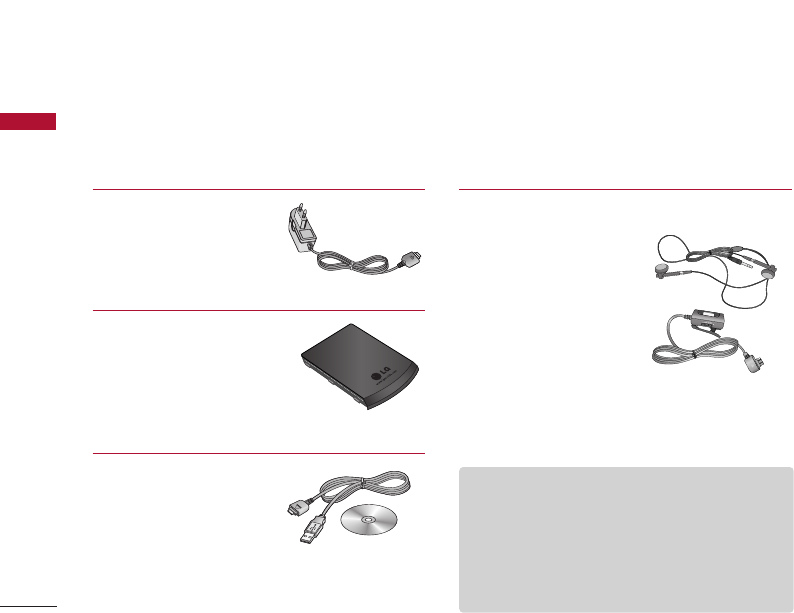
Accessories
98
Accessories
Travel Adapter
This charger allows you to
charge the battery while away
from home or your office.
Standard Battery
Data cable/CD
You can connect your phone
to PC to exchange the data
between them.
Hands free ear-microphone and controller combo
Stereo headset
Controller:
Answer & End key,
volume control, Hold button
and microphone.
After connecting the headset and the controller, plug
the end of controller into the headset jack on the right
side of the phone.
There are various accessories for your mobile phone. You can select these options according to your personal
communication requirements.
Note
]Always use genuine LG accessories.
]Failure to do so may invalidate your warranty.
]Accessories may vary in different regions: please
check with our regional service company or agent
for further information.

Technical data
99
Technical data
General
Product name :
KT610
System :
GSM 900 / DCS 1800 / PCS 1900 / W-CDMA
Phone usage temperature limit
Normal (55°C), When charging (45°C)